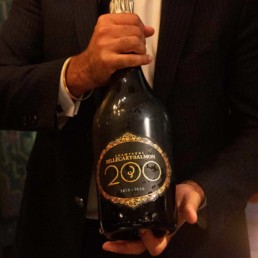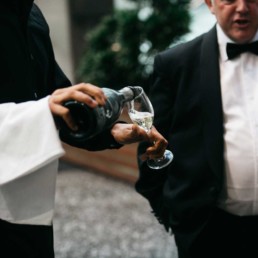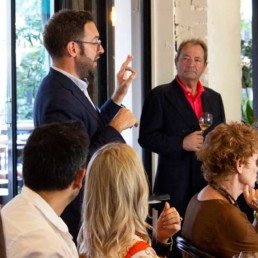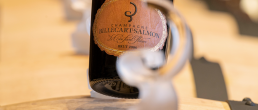
Arriving soon to our shores, not one, not two, but THREE Billecart-Salmon Vintage Champagnes – this is a circle-the-calendar event for every fine wine lover.
“Billecart-Salmon is in the very top echelon of Champagne houses – it is one of only four awarded the 10/10 rating”
Tyson Stelzer, Acclaimed Champagne Specialist
Champagne. How much magic is in this word? Then there’s Vintage Champagne – the ultimate luxury libation – the supernova of sparkling wines. Now there’s distinct wizardry at work! Add to that, the international supply chain having its Covid-accelerated meltdown, and we knew this was never going to be as easy as pulling a rabbit out of a top hat. Yet the planets have aligned, and Dhall & Nash is elated to offer as part of a global release these absurdly divine vintage champagnes from the prestigious Champagne House Billecart-Salmon.
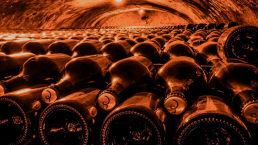
“The mark of Billecart is made not by the heavy footfall of concentration, power and presence, but rather the fairy touch of delicacy and crystal-clear fidelity.” – Tyson Stelzer, Acclaimed Champagne Specialist & Wine Critic
Clearly, the mystique of these vintage champagnes has reached far and wide – this is blue-chip buying! Vineyards, vintages, and producer are all best-in-class here—but if you’re a champagne collector, you already knew that! And if you’re not, well, time to catch up. This is champagne like no other – favoured by wine collectors, investors, wine geeks and of course, the rich and famous. Time to treat yourself like a superstar, a king, or a queen with a bottle or 6 of these rare NEW RELEASE BILLECART-SALMON Vintage champagnes
LE CLOS SAINT-HILAIRE BRUT MILLÉSIME 2006
Rarity and Complexity
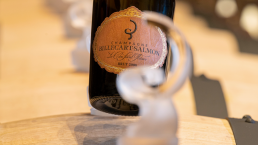
Billecart-Salmon’s Le Clos Saint-Hilaire is “the King of Blanc de Noirs, alongside Krug Clos d’Ambonnay, a towering masterpiece of profound mineral clarity and unfathomable complexity.”
Tyson Stelzer, Champagne Specialist
Here, in Clos Saint-Hilaire, they have revived the traditional Champenois methods of champagne production to improve the biodiversity of this generous land. This is a unique single one-hectare parcel where the vines, soil and subsoil are carefully tended with immense respect for the environment.
Indeed, several years ago, Billecart-Salmon decided to return to ancestral champagne-making methods in the Clos Saint-Hilaire by using work horses to plough and sheep to “mow” between the vines. This method of maintaining the soil and tending the vines increases porosity and biodiversity: the roots grow deep and the minerals they draw from the soil foster the growth of smaller, more concentrated grapes, revealing the terroir’s characteristic flavour.
Only the 7th Release
Following on from the 1995, 1996, 1998, 1999, 2002 & 2003 Vintages
Only the 7th release following on from the 1995, 1996, 1998, 1999, 2002 & 2003 vintages.
A Legend is Born:
Sixth-generation François Roland-Billecart, explains the genesis of Clos Saint-Hilaire: “In the 1950s my grandmother set aside this park-like space next to our house in Mareuil-sur-Aÿ with vines, flowers and fruit trees, for our enjoyment. Realising this outstanding terroir’s potential, my family decided to plant the first Pinot Noir vines here in 1964. We tried using the Pinot Noir to make white wine in small Burgundy barrels: an outstanding champagne was about to be born.”
It was conceived late one night as Antoine and Francois Roland-Billecart stood on the wall of the clos during harvest in 1995. With plenty of red wine in stock for their Rosé they decided they could afford to put this pinot noir in the cellar for a decade to see how it looked on its own. They were not disappointed. They called it Le Clos Saint-Hilaire after the patron saint of the church in Mareuil-sur-Aÿ.
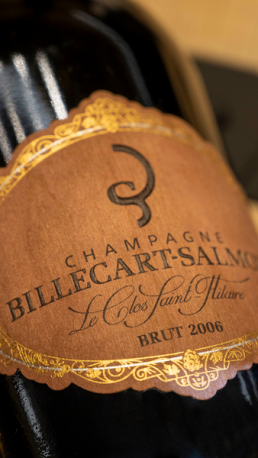
Le Clos Saint-Hilaire is a soaring masterpiece!
– Billecart website
The Parcel
An indulged terroir
The one-hectare of pinot noir in Clos Saint-Hilaire meets the strictest guidelines: a single enclosed, contiguous parcel with complete winemaking facilities on site. The terroir’s magic combined with the wine maker’s skills make this wine exceptional.
Made only from Pinot Noir vinified in casks, it develops an outstanding purity. Billecart-Salmon decided to add very little liqueur (dosage), after disgorgement in order to let the typicity of the pinot noir used to make this great wine evolve.
Appearance: the magic of a terroir blended with expertise and ancestral know-how, reveals a deep yellow gold hue, underlined by intensely golden reflections. The graceful effervescence of fine bubbles softened by the patina of time.
Aroma: a noble, racy expression with an extremely complex, vinous impact on the nose (touch of biscuit, fresh roasted hazelnuts, white pepper). A refined development highlighting the scintillating concentrations of ripe and intense fruit (nuts and sweet spices).
Palate: the ample and imposing texture, with hints of citrus fruit flesh and pears in syrup (candied lemon zest, mandarin pulp), emerges against a base note of panettone. With a richness bursting with flavours (puffed buckwheat and precious wood), the wine is carried by a fullness of taste with bewitching charm culminating in a deliciously chalky root mineral.
Harvested late September. Natural 11% alcohol. In barrel until April 2007. Disgorged November 2020. Dosage 2 g/l. Aged on lees/in the cellar: 159 months (13 years & 3 months)
Ageing potential: over 10 years+
(from Florent NYS, Oenologist and Billecart-Salmon’s Chief Winemaker)
“Try this wonderful Champagne with aged cheeses. An aged Comté or Parmesan work very well with the saltiness and nuttiness of these cheeses are balanced with the richness of the Champagne. But, just to push a bit the usual boundaries, pair it with a nice Wagyu tartare with black truffle shavings on top. The compact structure of Clos St Hilaire withstands perfectly with the tartare while the earthy characteristics of the champagne works well with truffle. As it is a champagne very particular, it deserves meditation and attention.”
Daniel Manetti, Wine Director, The Connaught, London
Accolades
“Rich nose, yeasty and so alive. The oak shows even more as the wine opens up, giving a cedar spice. Such underlying depth and richness with such a surprising mineral and acidic backbone with a verbena note, mandarin – the most citric of the lot. There is a subtler nuttiness here that is almost creamy, like a Belgian chocolate, almost oily on the finish yet with such direction.” Drink 2025-2045
18.5/20pts – Alistair Cooper MW – Jancis Robinson.com
“An incredibly fragrant nose shines with ripe, red-cheeked Mirabelle plum and even has an overtone of Kirsch. The palate is creamy and has a wonderful spine of freshness that only helps to underscore the generosity and roundness. The mousse is superfine, the autolysis is restrained yet profound, there is a textured mid-palate of concentrated red apple fruit with an edge of candlewax and a delicious reverberation of pepper. Exquisite.”
97/100 – Anne Krebiehl, MW – Falstaff International
“It was unfair to ask this wine to perform on a stage so crowded with opinionated and excellent wines, but 2006 LCSH didn’t bat an eyelid and, in fact, opened up exponentially over the hour that I managed to spend glued to this glass. With more perfume than I expected and crammed with chypre and white smoke details, these exotic details are perfectly counterpointed with terrific complexity and thousands of layers of fruit and spice… Either way, this is a staggeringly serious vintage for LCSH, and it might well prove to be another flawless release given time.”
19.5+/20 – Matthew Jukes, Wine Writer
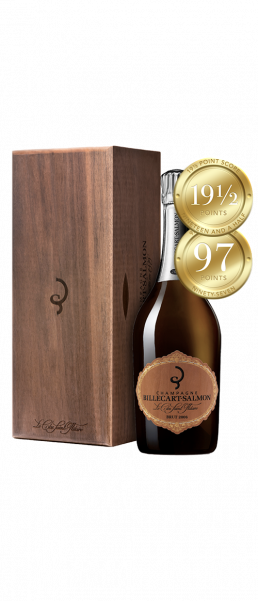
LOUIS SALMON BRUT BLANC DE BLANCS MILLÉSIME 2008
Purity and Minerality
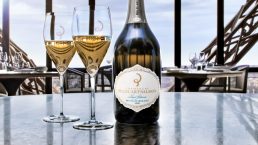
This cuvée was named in tribute to Louis, Elisabeth Salmon’s brother, who was passionate about oenology and highly involved in winemaking from the earliest creation of the House. Originating from the best parcels of the Côte des Blancs, this Blanc de Blancs vintage is endowed with purity and minerality.
The grapes are all from the Grand Cru villages of the Côte des Blancs, where the hills slope gently towards the sun and the vines root down into the chalk that is not far from the surface. This gives the grapes a unique mineral character that you don’t see anywhere else in Champagne. One third of the Chardonnay juice is fermented in barrels, which adds a slight spice to the aromas and oak texture to the palate and because they are older barrels, the impact of oak on the finished champagne is very subtle.
There’s notable elegance of a mineral and exceptionally precise Chardonnay with a natural balance that is a harmonious representation of the best parcels of grand crus of Côte des Blancs: Cramant (33%), Chouilly (40%) for the finesse, Avize (7%) for the force of character and Mesnil-sur-Oger (20%) for the structure and longevity.
When discussing the 2008 vintage of Louis Salmon, CEO Mathieu Roland-Billecart says that he believes many Champagne Houses released their 2008s too early. Billecart Salmon had this wine for over 11 years on its lees. “The cold fermentation gives you the acidic backbone… the downside is that you have to wait longer.” However, 2008 is rightfully hailed as a classic vintage in Champagne – and has the ability to age further to its advantage.
“It’s early days for this baby but it has everything it needs to start its life,”
Mathieu Roland-Billecart, CEO of Billecart-Salmon
(says somewhat paternally)
Appearance: crystal clear pale gold colour with delicate glints marked by a nuanced patina of yellow and green. A persistent and fascinating effervescence, brimming with light.
Aroma: the first expression is signed by an elegant, perfect, and complex maturity, yellow fruits, and citrus (candied mandarin, limoncello, conference pear). An aromatic profile of a sophisticated purity and a chalky, balanced, and crystalline character (cedar and raw butter).
Palate: a creamy sensation in the mouth with a beautifully chiselled finesse. Lovely refreshing balance with natural flavours (zest of citron, almond biscuit, and white pepper). This powerful wine with a majestic typicity prolongs its finish towards an aromatic persistence of incredible length (flesh of sweet citrus fruits, cardamom, and vanilla-flavoured cream puffs).
Tasting: the unique dimension of a great Blanc de Blancs, pure and intense, with a directness perfectly associated with its low dosage. Its potential and its balance express a remarkable finesse worthy of the most sophisticated food pairings (a casserole of whole calf sweetbread from Corrèze, a creamy shellfish risotto). Serve at: 10/12°
33% of the wines are vinified at low temperature in oak casks that are 15 years old on average
Maturation on lees/in the cellar: 11 years; Dosage: 7g/l
Ageing potential: more than 10 years
Accolades
“The delivery here is something to behold. It is clear from the nose that this wine is made with a horologist’s precision, and while everything starts quietly, there is an uncommon determination here that keeps on coming, leaving you panting with pleasure. On the palate, 2008 Louis perfectly balances extreme tension and white-knuckle drama with the most enchanting and serene jasmine, white tea, and linden blossom notes. It seems mesmerisingly composed from one side of the glass and hellbent on rearranging your taste buds via a national grid-sized electric shock from the other.”
20++/20 – Matthew Jukes, Wine Writer
“To look at the wine is shiny platinum gold, fine bead; the aromatics are pure and fresh with sea spray, crisp white apple and a sense of wet chalk, after 30 minutes more complexity reveals itself – more fruit and fresh nuts; in the mouth the wine is tense with tingly, mineral-driven acidity, ultra-fine texture, fresh, bright, beautifully balanced with pure Sicilian lemon, a touch of aspirin; the finish has you wanting more – it finishes dry, mineral and chalky, with lemon zest. Impressive, with a long life ahead of it.”
Peter Dean, Drinks Editor, The Buyer On-trade Magazine UK
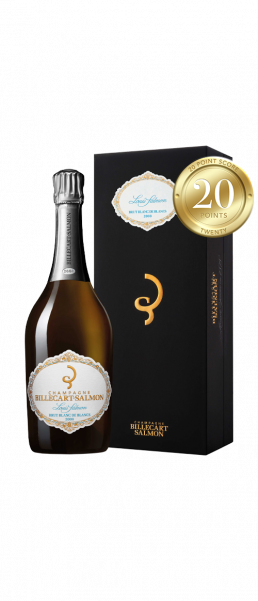
CUVÉE NICOLAS FRANÇOIS BRUT 2007
The Ultimate Distinction
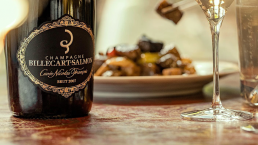
Champagne of the Millennium! That was the title bestowed upon Billecart-Salmon’s 1959 Cuvée Nicolas François in 1999, catapulting it’s reputation into the stratosphere.
Organised by Champagne Specialist Richard Juhlin, a committee of experts in Stockholm blind tasted 150 vintages from the most illustrious producers around, before declaring Billecart-Salmon’s Cuvée Nicolas François 1959 with the top spot (and the 1961 vintage coming in second).
“The perfect champagne, 1959 Billecart-Salmon, had everything one would expect of a luxury champagne, but in a seldom seen concentration and simultaneously with harmonious balance. A totally perfect champagne in its category, with a smoky, honey-smooth extremely long taste of walnut, orange blossom and chocolate. All who ever get to drink this fabulous wine just have to love the pleasure it grants. When you study the end results it is striking to see how obvious the victory was.”
The Great Tasting, by Richard Juhlin
Named in honour after Billecart-Salmon’s founder, this distinction is the ultimate reflection of this cuvée’s extraordinary caliber, and the mark of excellence on each vintages released since lived up to their predecessor, despite it’s incredibly big shoes to fill.
The 2000 release, 1998 and 1999 all boast scores in the mid-high 90’s from critics across the board, and now it’s the fantastic 2007’s turn. It results from the blending of Grands Crus from the classified Côte des Blancs vineyards (Chardonnay) and the Montagne de Reims (Pinot Noir). It’s vinification, partially in traditional oak casks, underpins the generous character of this fine, elegant and rich wine, and the reviewers are already raving about it.
“In 2007 we made all three of our prestige cuvées which is very rare… [2007 is a] huge, huge vintage. Because we took our time to pick the grapes, to have a three-week fermentation and long lees ageing, we took all we needed to make a great wine. I remember that after the first fermentation the wines were so juicy, so fresh, so crisp. I knew at that time that 2007 was very good”
Florent Nys, Billecart-Salmon Cellar Master
A beautiful golden yellow, glinting with bright sparkles. The glittering, crystalline appearance is set off by an eruption of finely chiseled bubbles. A balanced tension is achieved by the blossoming of the wine (peaches in syrup, fine apple tart and mountain butter) and embodied in the noble flavours that follow (fresh fig and wild berries). It combines all the richness of an aromatic curve, both complex and refreshing. Intense, fine notes of orchard fruits, associated with the character of stone fruits (Mirabelle plum and sweet cherry) and accentuated by the burst of a long floral note.
Accolades
“Pinot noir assumes a glorious lead in a magnificent display of red berry and cherry fruits, seamlessly fused to the bright lemon and pink grapefruit eut of magnificent chardonnay acidity.”
98 points – Tyson Stelzer
“This beautiful Champagne is amazingly at its peak. Not too mature, not too young, the wine is in fine balance, showing some nervy edge as well as touches of toast. With a small amount of wood vinification, the wine has extra fullness.”
97 points – Wine Enthusiast
“The 2007 Brut Cuvée Nicolas François Billecart is positively stellar. Elegant, polished and sophisticated, the 2007 dazzles with effusive aromatics and gorgeous balance. It’s not an obvious wine, though, but rather a Champagne built for long, patient cellaring.”
97 points – Vinous
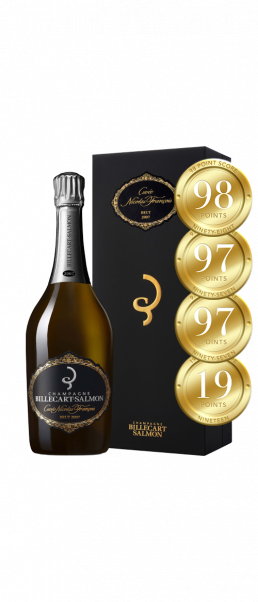
What’s the big deal with vintages in Champagne?
Perhaps no other wine region on earth is as vintage driven as Champagne. Because of its location in north-eastern France this region really pushes the envelope for grape growing – it’s marginal here. Many of the harvests in any given decade are not suitable for the production of top-quality, single-vintage Champagne.
Most of the Champagne produced is non-vintage, meaning that the wine is a blend of grapes grown during many different vintages. Single-vintage Champagne is usually only produced three or four times per decade and makes up less than 5% of total Champagne production. The rarity of these top vintages makes the great years even more special, with exceptional and rare vintages commanding high prices at auction. With climate change, Champagne has seen a string of roller-coaster vintages during the past decade.
Nevertheless, a Champagne’s vintage remains one of the most important factors for collectors and lovers of fine aged Champagne.
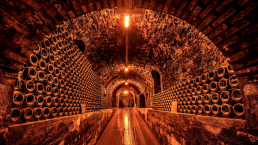
“Perfect growing conditions and winemaking finesse are required to create vintage champagne.”
Nick Bullied, Master of Wine
2006 A complicated vintage in Champagne. The vines suffered a mixed summer with a scorching July followed by a particularly rainy August. The rain in September then compromised the sanitary state of the grapes. The harvest had to be picked very quickly. Luckily for Clos Saint-Hilaire, Pinot Noir had the most success this year, rivalling Meunier and even Chardonnay. 2006 is vintage-dated in all champagne houses except Bollinger.
Jancis Robinson MW on the 2006 vintage: “An exceptionally hot and sunny June and July with grapes in fine fettle but a dank August left producers fearful of under ripeness. Fortunately, warm, bright conditions in September redressed the balance. Wines are supple and expressive.”
2008 A brilliant “bullseye” vintage. The 2008 vintage is widely considered one of the top two vintages of this century so far. Fast on the heels of the renown and legendary 2002. The growing season got off to a rocky start with an unusually cool and damp spring. The cool weather persisted throughout much of the summer, but September brought idyllic weather that sped up ripening. By harvest, the grapes were in near-perfect condition. They had high levels of both sugar and acid, and growers were extremely happy with the results. Subsequent tastings have proven the wines to be of exceptional quality. The vintage is defined by its crisp, linear structure and racy, energetic taste profile. Given its exceptional structure and balance, 2008 is estimated to be one of the longest aging vintages.
A Champagne House Extraordinaire
A brief history of Billecart-Salmon
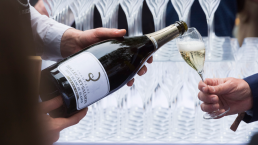
During the 17th century, Pierre Billecart, an esteemed winemaker, and ancestor of Nicolas François Billecart, was summoned by King Louis XIII who authorised him to create his own coat of arms. Thus, when the Champagne House of Billecart-Salmon was born in 1818 from marriage of Nicolas-François Billecart and Elisabeth Salmon, his descendants proudly reinstated them.
Situated in the village of Mareuil-sur-Aÿ, near Epernay, Champagne Billecart-Salmon is still a family-run organisation with seventh generation Mathieu Roland-Billecart overseeing business. Alongside the family members are a dedicated team of people who hold the House values dear to them such as Chef de Cave François Domi who retired in 2016 after 30 years with Billecart and handed over to his deputy Florent Nys who started with the business in 2005. The vineyards are overseen by Denis Blée, and all of the team are members of the eight strong “tasting committee” along with 6th generation François Roland-Billecart and Antoine Roland-Billecart and fifth generation Jean Roland-Billecart. By 2020 production had expanded with grapes now coming from 300 hectares and 40 crus mostly within 20 kms of the winery.
Always conscious to improve the quality of their champagne, in the fifties the House established the technique of chilling the must combined with the use of stainless-steel tanks for a longer fermentation at a lower temperature. Over time, the wines conserve their freshness, and the aromas intensify, allowing Billecart-Salmon champagnes to deliver all they promise.
Billecart-Salmon is discreetly but significantly continuing to evolve. Since 2010, a new cellar has housed some 400 barrels for vinification and élevage, and since 2018, another cellar is home to oak foudres retaining some 80,000 litres of reserve wine. Meanwhile, Billecart’s wines are spending longer and longer sur lees, and fruit sourcing is changing—with more grand cru fruit replacing premier cru fruit—while volumes remain the same. Based on the trials underway in their emblematic Clos Saint-Hilaire, the next frontier will be the vineyards.
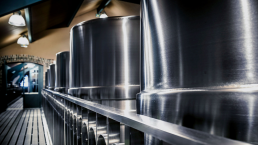
Billecart-Salmon “…is going from strength to strength.”
William Kelley, The Wine Advocate
The House style is intensely bright and fruity with an increasingly oxidative tone brought about by the recent re-introduction of oak. The Billecart-Salmon portfolio is vast, but they are best known for their prestige cuvées, Cuvée Nicolas-François, Cuvée Elisabeth Salmon Rosé, and Cuvée Louis Salmon.
In 1999, Cuvée Nicolas-François 1959 was awarded ‘Champagne of the Millennium‘ by a committee of experts at a blind tasting session involving 150 vintages from the most illustrious champagne producers. The 1961 vintage, for its part, came second! WOW!
The jewel of the estate, however, is the single-vineyard champagne Clos Saint Hilaire: a monstrously powerful cuvée – the 2006 now available in extremely limited quantities.
Do not delay, if you are serious about filling your wine cellar with true icons, these Billecart-Salmon Vintage Champagnes should be snapped up fast (available by pre-order) before our sadly meagre Dhall & Nash allocation runs dry!
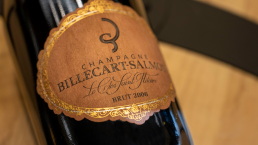
“we can rest assured that vintage Champagne is definitely still a force to be reckoned with…”
Simon Field MW, Decanter
By the way…You may ask that in a world happy enough with prosecco and pét-nat, are these vintage champagnes truly worth it? Absolutely. Even if our modern day lives are full of distractions and disappointments, a surprisingly small number of deluxe Champagne Houses, such as Billecart-Salmon, still represent the highest-quality fizz you can find. These are hauntingly powerful masterworks. In other words, an astoundingly sublime wine experience. What you’re paying for are the very best grapes from grands crus and premiers crus vineyards in the very best years; with extra years of aging in the Champagne’s cold, chalky cellars (which gives the wines more complex flavours and aromas); the undoubted rarity factor; and, of course, Prestige with a capital P!
Billecart-Salmon is certified « High Environmental Value » and in 2017, was awarded the
« Sustainable Viticulture in Champagne » certification for its winemaking
